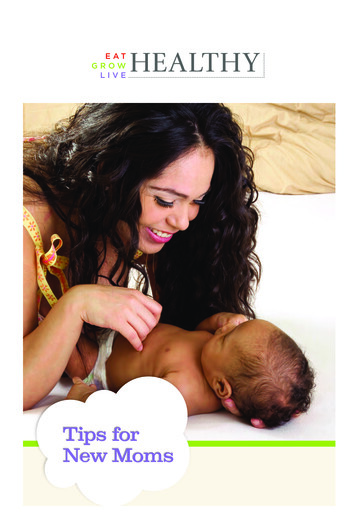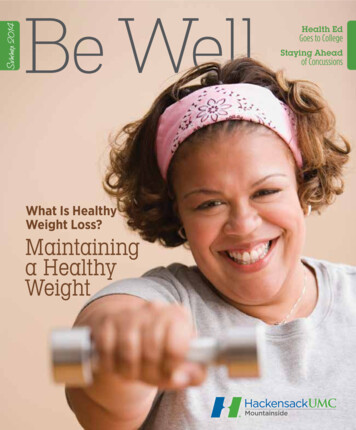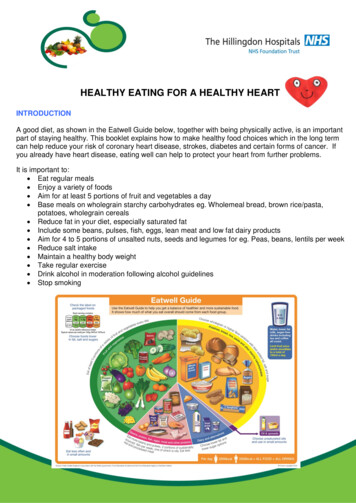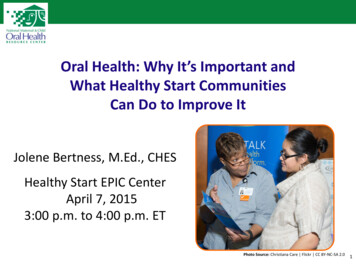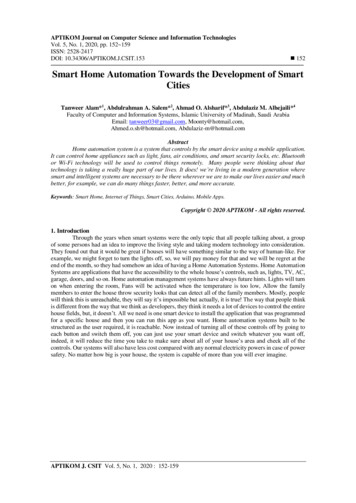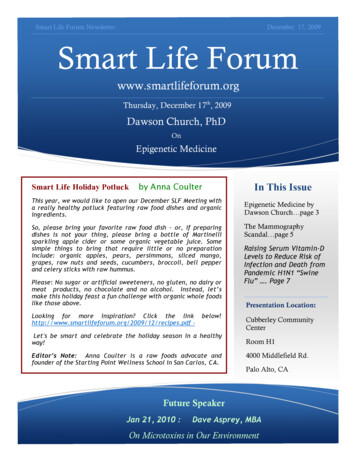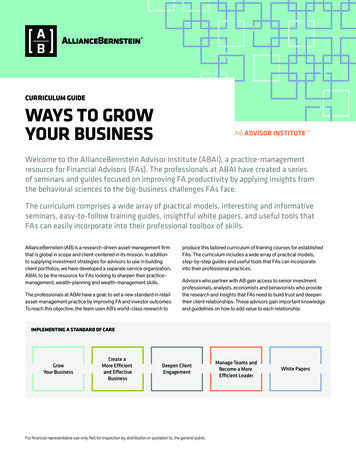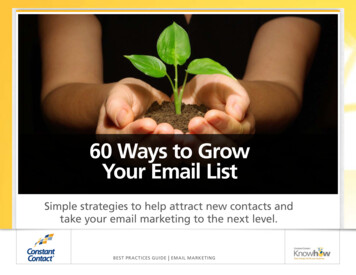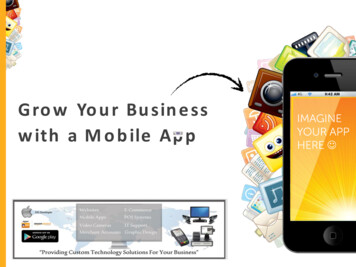
Transcription
Healthy Start, Grow SmartYour Two-Month -Old
Healthy Start,Grow SmartYour Two-Month-OldPrepared by:U.S. Department of AgricultureU.S. Department of EducationU.S. Department of Health and Human Services2002
AcknowledgmentsThis publication was an initiative of Laura Bushas the FirstLady of Texas and sponsored by the Texas Department of Health. PresidentBush and Mrs. Bush have asked that this series of booklets be revised anddistributed by the U.S. Department of Agriculture, U.S. Department ofEducation and the U.S. Department of Health and Human Services.We would like to thank the Texas Department of Health for their cooperationand assistance in bringing this publication to families across the UnitedStates. In addition, we recognize the contributions that Susan H. Landry,Ph.D., Craig T. Ramey, Ph.D. and many other individuals made in thedevelopment of this magazine.Here’s What’s InsideWatching Your Baby Grow . . . . . . . . . . . . . . . . . . . . . . . . . . . . . . . . . . . . . .1A Healthy Baby . . . . . . . . . . . . . . . . . . . . . . . . . . . . . . . . . . . . . . . . . . . . . .2When To Call the Doctor . . . . . . . . . . . . . . . . . . . . . . . . . . . . . . . . . . . . . . .4Sleeping Patterns . . . . . . . . . . . . . . . . . . . . . . . . . . . . . . . . . . . . . . . . . . . . .5Bowel Habits . . . . . . . . . . . . . . . . . . . . . . . . . . . . . . . . . . . . . . . . . . . . . . . .5Feeding Your Baby . . . . . . . . . . . . . . . . . . . . . . . . . . . . . . . . . . . . . . . . . . . .6Formula Feeding . . . . . . . . . . . . . . . . . . . . . . . . . . . . . . . . . . . . . . . . . . . . .8Protect Your Baby’s Future Teeth . . . . . . . . . . . . . . . . . . . . . . . . . . . . . . . .9What’s It Like To Be Two Months Old? . . . . . . . . . . . . . . . . . . . . . . . . . . .10Baby Movements . . . . . . . . . . . . . . . . . . . . . . . . . . . . . . . . . . . . . . . . . . . .11Baby Games . . . . . . . . . . . . . . . . . . . . . . . . . . . . . . . . . . . . . . . . . . . . . . . .12What To Do When Your Baby Cries . . . . . . . . . . . . . . . . . . . . . . . . . . . . . .13Keeping Your Baby Safe . . . . . . . . . . . . . . . . . . . . . . . . . . . . . . . . . . . . . . .14Crib Safety . . . . . . . . . . . . . . . . . . . . . . . . . . . . . . . . . . . . . . . . . . . . . . . . .15Single Parents . . . . . . . . . . . . . . . . . . . . . . . . . . . . . . . . . . . . . . . . . . . . . .16Single Teen Parents . . . . . . . . . . . . . . . . . . . . . . . . . . . . . . . . . . . . . . . . . .17Support for the Single Parent . . . . . . . . . . . . . . . . . . . . . . . . . . . . . . . . . .18Information Resources for Families . . . . . . . . . . . . . . . . . . . . . . . . . . . . . .18
Watching Your Baby GrowAt two months of age, your baby willbegin to notice and reach out to the worldaround her. She can see better now. She canwatch a person or object moving directly infront of her. She is more alert and can respondto you more. The world around her is moreinteresting to her.Your baby is gaining more strength in her neck and shoulders. This allowsher to hold her head up better and to see more.Your baby also may begin to make some new sounds. She may start cooingand making sounds like "ah-ah-ah" and "ooh, ooh, ooh." And she may makesqueaking and gurgling noises.Your baby will try to bring her hands to her mouth. She will do this often.When her fingers reach her mouth, she will not be good at keeping themthere. She will get better at this as she gets older. She can also tightly holda toy, such as a rattle, when you put it in her hand. But she will have trouble letting it go.Her movements are no longer jerky but grow smoother day by day. Shemay be awake more during the day. If she is an active baby, she may bemoving all the time when she is awake.Healthy Start, Grow Smart1Your Two-Month -Old
A Healthy BabyYour baby needs to see the doctor on a regular basis. These visits areimportant for her health and development. They are also opportunities tolearn more about your baby. Your doctor can discuss with you whetheryour baby: Is eating well Is growing normallyAt your baby’s two-month checkup,she will be given shots to protect heragainst illnesses. Ask the doctor ornurse to tell you what kinds of reactions your baby may have to theshots. Also, find out what to do aboutthose reactions. It is a good idea to keep a record of all your baby’s shots. Is developing social, learning and physical skills properlyWhile you are at the doctor’s office, you can ask questions about taking care ofyour baby. You can also talk about any problems you may have being a parent.Find a doctor you like and feel comfortable with. Going to the same doctoreach time is a good idea, if you can. Using the same doctor makes it easierto keep track of your baby’s health and growth.If your baby is eligible for Medicaid, she can get free checkups. You can callyour local social welfare, health or family services office to see if you qualifyfor Medicaid services.During the visit, your doctor will: Do a physical exam Check her growth and development Check her ability to move Give her shots to help protect her against a number of diseases Do a hearing and eye exam Check her height, weight and head size Check what she is eatingIf you don’t have health insurance for your baby, you can learn aboutresources in your state by contacting the U.S. Department of Health andHuman Services Insure Kids Now Program at 1-877-KIDSNOW. You canalso visit their Web site at www.insurekidsnow.gov for more informationabout free or low-cost health insurance for children. Many public librariesoffer free access to the Internet and provide help for first-time users. Treat any medical problemsHealthy Start, Grow Smart2Your Two-Month -OldHealthy Start, Grow Smart3Your Two-Month -Old
Sleeping PatternsWhen To Call the DoctorTwo-month-old babies usually sleep better at night. By now, your babyAt your child’s first checkup, ask yourdoctor what he or she considers a fever in ababy who is your baby’s age and at what temperature you should call him or her. Also, goover with your doctor what problems youshould call about immediately.When your baby is sick, use a thermometerto check for fever. Place the thermometerunder her armpit for four minutes and gently cuddle her while you holdher arm to her side. Always call the doctor when a baby who is threemonths old or younger has a fever. Your doctor will tell you what to do tohelp your baby.When your baby is sick, be sure to pick her up and comfort her. Call yourdoctor right away if your baby has any of these symptoms: A stiff neck, or if she can’t move her head to any position A wheezing or crackling noise when she breathesmost likely has a routine for sleeping and eating. Probably she goes at leastthree hours without a feeding. A baby this age usually sleeps longer than anewborn at night, but each baby is different.After you feed your baby, hold her and rock her for a while. You can put herto bed at night when she is quiet, even if she is not asleep. You can sit downbeside her and pat her gently or sing softly. Doing this will help an activebaby learn to calm herself down. She may want to suck a pacifier or herthumb or finger as she gets sleepy.Every baby will have her own pattern. Every baby will have different thingsshe likes to help her to go to sleep.Bowel HabitsBaby’s bowel habits may change. Many breastfed babies may changetheir bowel habits. They may go from having several bowel movements perday to having fewer than one a day. This may have happened earlier, or itmay start happening now. This is because breast milk is easy to digest. Aslong as the bowel movement is soft, the baby is not constipated. Pulling on her ears as if they are painfulThe bowel habits of a formula fed baby are similar to the breastfed baby.Like a breastfed baby, a formula fed baby will start out with several bowelmovements each day. This number will decline to about one a day. Yourbaby may have wet diapers often. This means she is drinking the rightamount. A severe cough or red throat A fever of any kindHealthy Start, Grow Smart4Your Two-Month -OldHealthy Start, Grow Smart5Your Two-Month -Old
Feeding Your BabyBreastfeeding is healthy for you and your baby. Here are some reasons why breastfeeding is best: Breast milk can help protect your baby against illness. It can protecther from allergies. The American Academy of Pediatrics says it’s goodfor babies to be breastfed for the first year of life. It’s best for mom. Many breastfeeding mothers lose the weight theygained while pregnant faster than mothers who do not breastfeed.Follow your baby’s lead. Babies tend toget as much milk as they need whenyou let them nurse when they wantand for as long as they want. The moreyour baby nurses, the more milk you will produce. Your milk supply willkeep up with your baby’s demand.How do you know when your baby is hungry? Here are some hunger signsto be aware of: It creates a bond between mother and baby. You can learn your baby’sEarly hunger signs:signals faster. Breast milk is easier to digest than formula and you don’t have toprepare bottles or formula. Breast milk is always ready. Babies do notbecome constipated from breast milk.Each baby has her own feeding schedule. Some babies need to nurse moreoften than others do. In general, nursing babies need to be fed at leasteight to 12 times in a 24-hour period. That means feedings every two tothree hours. If your baby has not fed for several hours and then dozes offafter only a few minutes of nursing, gently wake her to encourage her tocontinue nursing. Try to help your baby feed until your breasts are emptied of milk or at least 15 minutes from each breast.If you have any questions or problems with breastfeeding, talk to yourdoctor, nurse or WIC breastfeeding counselor. To learn more about breastfeeding, you may call La Leche League at 1-800-LALECHE or visit theirWeb site at www.lalecheleague.org/.Healthy Start, Grow Smart6Your Two-Month -Old Head moves toward voice, mouth opens Lips smack, tongue reaches outward Hands move "randomly" Fists find mouth Infant begins fussingLate hunger signs: Brow furrows Mouth widens, head moves quickly from side to side Fists clench, seeking the mouth Baby criesHealthy Start, Grow Smart7Your Two-Month -Old
Protect Your Baby’s Future TeethEven when your baby is only two monthsold, you should keep her gums healthy andclean. Gently wipe her gums with a wet, clean,soft cloth every day. The most important thingto remember is never to put your baby to bedwith a bottle. And never prop up the bottle atany time.Formula FeedingHow you feed your baby is up to you.Breastfeeding is best for you and your baby. Butthere may be reasons why you will need to feedyour baby infant formula.Remember always to hold your baby while bottle feeding. Never put thebottle in your baby’s mouth and leave her.Here are the three basic types of formula:Any kind of drink except water can cause ababy’s teeth to decay, even breast milk andinfant formula. Other liquids that cause toothdecay are powdered fruit drinks, soda and juice. Any drink that containssugar can cause tooth decay when your baby gets older. A two-month-oldbaby should drink only breast milk, formula or water. Powdered formulas that are mixed with waterHere are some tips to follow to protect your baby’s teeth: Liquid concentrates that are mixed with water Pre-mixed formulas ready to put in the bottle or already in ready-tofeed bottlesleave a bottle in your baby’s bed. If your baby needs a pacifier at bedtime, make sure it is clean and dry.When you mix powdered formulas or liquid concentrate formulas, followthe package directions exactly and add just the right amount of clean water.Be sure not to add too much or too little water. If the formula is premixedand ready-to-feed, do not add any water.8Do not dip the pacifier in honey or sweet liquids. Your baby might likethe sweet taste, but these liquids will cause tooth decay when her teethcome in. Germs in honey can also make a baby sick. Help prevent the spread of germs to your baby. You and your familyshould have regular dental checkups to help keep your own teeth andgums healthy. Clean the nipples of your baby’s pacifiers and bottles bywashing with soap and rinsing carefully and thoroughly with cleanwater. Do not lick your baby’s pacifier or bottle nipples to "clean" them.Talk to your doctor about the best formula for your baby.Healthy Start, Grow Smart Always hold your baby during feedings. Do not prop up the bottle orYour Two-Month -OldHealthy Start, Grow Smart9Your Two-Month -Old
What’s It Like To Be Two Months Old?Baby MovementsAt two months of age, your baby has more control of her body. Whenshe was younger, she may have looked uncoordinated when she waved herarms and legs. Now she can move her arms and legs more smoothly.She can’t reach yet, but if you touch her hand with a toy, her hand willmove toward the toy.Her hands are above her head when she plays. She can twist her body andhead from side to side. She can put her hand in her mouth for sucking.Some babies may make crawling movements with their knees when lyingon their tummies. My head is a little wobbly when I am propped up. Put your handbehind my neck and head for support.You will see changes in how your baby uses her eyes, ears and hands. Hereare things to look for in your two-month-old: I can hold my head up for a few seconds when I’m on my stomach. She watches her hands more. I hold onto things for a little while. She can watch an object several feet away. She especially likes to watch I move my arms and legs. I "bicycle" with my feet when I get excited.moving objects or people. I gurgle, laugh and smile when I am happy. She reacts to sounds by looking toward the sound. I cry when I am hungry, scared or uncomfortable. When she hears a sound, she may stop moving until she decides whereit is from. I am aware of different voices and people. I stay awake during the day. But I usually take naps throughout the day. Since her hands are open more often, she can touch more objects. Sheis learning the difference between hard and soft. She likes it whensomething soft is placed in her fingers. I make cooing sounds. I begin to stare at my hands. I follow you with my eyes to watch you move around. I stare at people and at things. I smile at other people, not just at my mother. I quiet down when I suck my fingers, a bottle or a pacifier.Healthy Start, Grow Smart10Your Two-Month -OldHealthy Start, Grow Smart11Your Two-Month -Old
Baby GamesWhat To Do When Your Baby CriesIt is very important to talk to your baby. You may wonder how muchYour baby has an important way of telling you she needs some-of what you say is understood by your baby. But don’t worry. When youtalk, your baby is listening. When you talk to babies, use simple words andphrases. You should speak clearly. You can get your baby’s attention bywidening your eyes and mouth. You can also change the pitch and tone ofyour voice. These are your baby’s first lessons in communication. Here aresome tips for talking to your baby:thing –crying. Crying can mean many things. Here are a few of the thingsyour baby may be trying to tell you with her crying: I am hungry. I want to be held. I hurt (gas, colic). I’m bored. I don’t feel well. I’m tired. Look at your baby’s eyes while you are talking to her. My diaper needs to be changed. I’m lonely. Call your baby by her name. I’m afraid. Keep your talk simple. Say "pretty baby." Use the words "mommy" and"daddy" when you talk to her. Watch for your baby’s expressions and listen to her sounds. Make thesesame sounds and facial expressions back to her. Add gestures to your talk. Say "wave bye-bye to the dog" as you wave tothe dog. Ask your baby questions. "Would Maria like to have her milk now?""Does Maria want to go outside?" Ask the questions even though shecan’t answer. Talk about what you are doing. As you dress, bathe and change yourbaby, talk about what you’re doing. Read to your baby. Babies love nursery rhymes and poems. You can evenuse a lively voice and read your favorite magazine or book to her. If youcan, use books with stories that include a baby, a rattle or other common things. (You can find lots of children’s books at your public library.) Sing to your baby. It is important while she begins to learn language skills. Watch for signals from your baby when you are talking to her. If she isHearing your baby cry can be hard on you. It is natural for parents to wantto soothe their baby. Here are several ways of meeting your baby’s needs: Hold your baby. Check her diaper. Rock your baby. Pat your baby while she lies on her back. Walk your baby. Put your baby where she can see activity. Feed your baby. Talk to your baby. Burp your baby. Give your baby a pacifier.Babies should not be left to cry alone. It was once believed that picking up acrying baby would spoil her. We now know that babies cry less if their needsare met. They learn to trust that adults will take care of them. At this earlyage, one of the best ways to comfort her is to pick her up and hold her.When an infant’s crying increases for unexplained reasons over a long periodof time and nothing you do to soothe her seems to help, consider calling yourdoctor. Call your doctor if you think pain or illness may be causing the crying.smiling and keeping eye contact, she is saying she wants you to keepon talking.Healthy Start, Grow Smart12Your Two-Month -OldHealthy Start, Grow Smart13Your Two-Month -Old
Keeping Your Baby SafeCrib SafetyHere are some ways to keep your baby safe:Your baby’s crib needs to be a very safe place. Here are some tips to follow to make sure the crib will not harm your baby: Never shake your baby, either in angeror in play. Shaking a baby can causebrain injury or death. If you smoke, quit! If you can’t quit,smoke outside, away from the baby.Second-hand smoke can cause a numberof childhood illnesses or make them worse. These include asthma,ear infections and sinus infections. Put your baby to sleep on her back. If your baby has a health problem, your doctor may tell you to put her in another position.Otherwise, always put your baby to sleep on her back. Make sure hercrib has a firm, flat mattress. Make sure your baby’s crib is sturdy and safe. There should be noloose or missing hardware. Babies can be hurt in an unsafe crib. Always use the safety straps in strollers, infant seats, changing tablesand baby swings. Use an infant car-safety seat according to the directions. Never leave your baby alone in a car. Don’t leave her alone for even afew minutes. If you buy a new mattress, be sure to remove and discard all plasticwrapping. The mattress should fit the crib snugly so your baby cannot slipbetween it and the side of the crib. Be sure the crib slats are no more than 2 3/8 inches apart so that yourbaby’s head can’t get caught between them. If you use a bumper pad, make sure that it goes all the way around thecrib. Make sure the bumper pad is tied with at least six straps or ties.Ties should be no more than six inches long to prevent strangulation.Make sure your baby cannot get caught between the mattress and thebumper pad. Mobiles and other hanging toys should be high enough so that yourbaby cannot reach them. Do not put toys, stuffed animals, pillows or extra bedding in yourbaby’s crib. These things can block your baby’s breathing. Toys should not be tied to the crib because your baby can get caught inthe cords. Cutouts in the headboard and footboard should be smaller than yourbaby’s head so she doesn’t get trapped in them. Don’t use necklaces to hold a baby’s pacifier. A necklace or stringcould wrap around her neck and choke her. Place the crib away from windows. Cords attached to blinds or curtainscan choke your baby if she gets caught in
Healthy Start, Grow Smart 2 Your Two-Month-Old Healthy Start, Grow Smart 3 Your Two-Month-Old. Sleeping Patterns . Head moves toward voice, mouth opens . should have regular dental checkups to help keep your own teeth and gums healthy.
